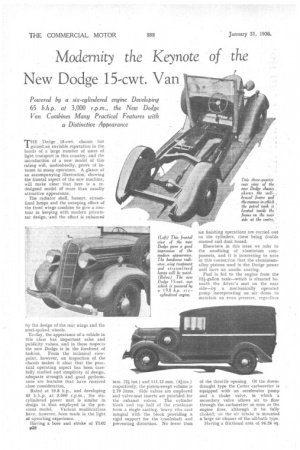Modernity the Keynote
Page 38

Page 39

If you've noticed an error in this article please click here to report it so we can fix it.
of the
New Dodge 15-cwt, Van
THE Dodge , 15-cwt. chassis has gained an enviable reputation in thehands of. a large number of users of light transport in this country, and the introductibn of a new model. of this rating will, undoubtedly, prove of interest to many operators. A glance at an accompanying illustration, showing the frontal aspect of the new machine, will make clear that here is a redesigned model of more than usually attractive appearance.
The radiator shell, bonnet, streamlined lamps and the sweeping effect of the front wings combine to give a contour in keeping with modern privatecar design,)and the effect is puha 'iced
by the design of the rear wings and the steel-spoked wheels.
To-day, the appearance of a vehicle in this class has important sales and publicity values, and in these respects the new Dodge is in the forefront of fashion. From the technical viewpoint, however, an inspection of the chassis makes it clear that the practical operating aspect has been carefully studied and simplicity of design, adequate strength and good performance are features that have received close consideration.
Rated at 19.8 h.p., and developing
65 bhp. at 3,000 the sixcylindered power unit is similar in design to that employed in the previous model. . Various modifications have, however, been made in.the light of opera tin expprience_.
Having a bore and stroke of 73.02 28 MM. (2i ins.) and 111.12 mm. Otitis.) respectively, the piston-swept volume is 2.79 litres, Side valves are employed and valve-seat inserts are provided.for the exhaust valves. The cylinder block and top half of the crankcase form a single casting, heavy ribs cast integral with the block providing a rigid support for the crankshaft and preventing distortion. No fewer than six finishing operations are carried .out on the cylinders, these being double reamed and dual honed.
Elsewhere in this issue we refer to the anodising of aluminium components, and it is interesting to note in this connection that the alurnirfiumalloy pistons used in the Dodge power unit have an anodic coating.
Fuel is fed to the engine from the 12i-gallon tank—which is situated beneath the driver's seat on the near side—by a mechanically operated pump incorporating an air dome to maintain an even pressure, regardless of the throttle opening. Of the downdraught type the Carter carburetter is equipped with an accelerator pump and a choke valve, in which a secondary va!ve allows air to flow through the carburetter so soon as the engine fires, although it be fully choked; on the air intake is mounted a large air cleaner of the oil-bath type.
Having a frictional area of 94.24 sq. ins, the dry single-plate clutch is built unit-wise with the engine and threespeed gearbox, the latter being of the constant-mesh type giving silent running on all ratios.
Immediately behind the gearbox is mounted the hand-operated contracting brake, which is carried on the front flange of the front roller-type universal joint. A single tubular propeller shaft transmits the drive to the spiral-bevel rear 'axle which has 'semi-floating shafts. The standard axle ratio is 4.875 to 1.
The frame side-members . are upswept over the rear axle and are of sturdy, design; the maximum depth is 6 iris., the width of the flange being
2 ins, and the thickness in. Boxtype cross-members give adequate bracing to the side-members and the frame forms a rigid structure.
Suspension is effected by semielliptic springs both fore and aft, these being equipped with rebound plates to give a good damping effect so that it becomes unnecessary to fit shock absorbers. Anti-roll shackles are provided at the rear end of both the front and rear springs, the forward shackle in each case being of the rubberbushed type.
:The four-wheel brakes are operated by the Lockheed hydraulic system, the fluid being delivered from the master cylinder through a single steel tube to a distributing device mounted beneath the bonnet on the inner lace of the frame on the near side. From this device three pipes lead to the near-side and off-side front brakes and to the rgar brakes, the last being divided at the rear, flexible connections, carried on the axle, connecting up to each wheel cylinder. Centrifuse brake drums are used, these being 10 ins, in diameter. . A five-lamp lighting set is provided, the headlamps having a dipping device operated by a foot button, whilst the battery is of the 12-volt type and is of
ample capacity. The equipment includes a by-pass thermostat in the engine cooling system, a, temperature
indicator, fuel gauge, windscreen wiper and a positive-shift type starter.
A further point worthy of note concerns the method of supporting the power unit. Whilst a rigid mounting is used at the rear, a single rubber mounting is employed at the front to damp any incipient vibration. A useful feature, too, is that the wings, bonnet, and all expcised sheet metal parts are rust-proofed by the Bonderizing process prior to painting.
Having a wheelbase of 9 ft. 8 ins., the standard vehicle is equipped with a British body measuring 6 ft. 6 ins.' long, 4 ft. 6 ins, wide and 4 ft. 31 ins. high.
. With 6.50-16 tyre equipment, the chassis is priced at £175, the figure for the complete van being £215.




















































































